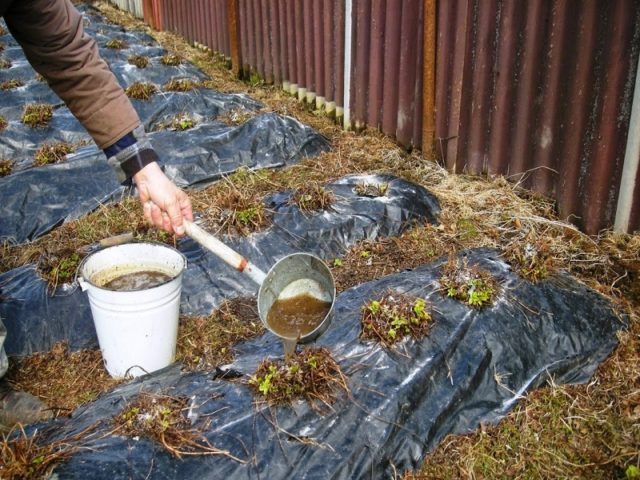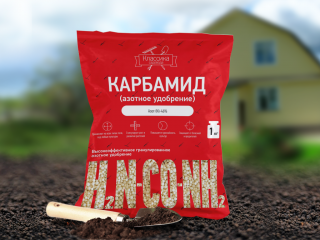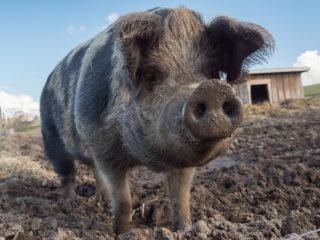Content
- 1 Can pigeon droppings be used as fertilizer?
- 2 Which is better - pigeon or chicken droppings?
- 3 Composition of pigeon droppings
- 4 What are the benefits of pigeon droppings?
- 5 How to collect and store pigeon manure
- 6 How to use pigeon droppings as fertilizer
- 7 Rules for applying fertilizing
- 8 Features of fertilizing different crops
- 9 Conclusion
- 10 Reviews of pigeon droppings as fertilizer
Bird droppings and, in particular, pigeon droppings are considered the most highly effective for feeding plants and are easy to use. Organic fertilizer is very popular among gardeners due to its effectiveness and availability. Despite the ease of use, soil fertilization should be carried out according to certain rules.
Can pigeon droppings be used as fertilizer?
Pigeon droppings are widely used as fertilizer due to their chemical composition. It includes microelements and essential nutrients. The action of the fertilizer is fast and more productive than manure. When growing various crops, the assimilation of organic matter gives good yields.
The amount of microelements in pigeon droppings is greater than in horse or cattle manure. This is explained by the feeding habits and structure of the digestive system of birds.The nitrogen content in the waste products of pigeons is 4 times higher than in horse manure, and the phosphorus content is 8 times higher than in cow manure.
Mineral fertilizers increase yields, but can accumulate in the final product. This manifests itself in exceeding the norm for nitrate content in vegetables and fruits. Pigeon droppings are environmentally friendly. All microelements contained in it are well absorbed by plants.
The use of wild pigeon waste is not recommended. Their diet is not regulated; their diet may include waste contaminated with parasites and infections. To prevent their spread, pigeon droppings from wild birds should not be used.
Which is better - pigeon or chicken droppings?
Chicken manure is most often used by gardeners and gardeners. It contains magnesium oxide, lime, phosphoric acid, sulfur, and potassium. It is rich in nitrogen content. Chicken manure can provide nutrition to garden crops without increasing the concentration of salts in the soil.
When comparing chicken with duck, the former contains a greater amount of nutrients. Feeding with pigeon droppings is used much less frequently, since this bird is not often bred on an industrial scale. At the same time, it is the most effective. In the fresh state, pigeon is superior to chicken in nitrogen content (17.9%) and phosphoric acid (18%), but the composition largely depends on the poultry feed.
The advantages of fertilizer include:
- rich chemical composition;
- performance;
- long-term storage ability;
- Possibility of use in different types;
- preparing high-quality compost.
With the correct use of pigeon droppings, the structure of the soil, its chemical composition is improved, and it is saturated with nutrients, which enhances the biological activity of the soil.
Composition of pigeon droppings
The chemical composition of pigeon droppings depends on what the birds are fed. The grass and legume diet of pigeons leads to an increase in nitrogen. Grain with chalk additives - helps to increase potassium and calcium in the fertilizer. In addition, it includes:
- magnesium;
- manganese;
- iron;
- calcium;
- molybdenum;
- sulfur;
- boron
The longer pigeon droppings are stored, the lower the nitrogen content becomes. A particularly rapid drop in the indicator occurs when it is kept in open heaps. To preserve the beneficial properties of the fertilizer, it is necessary to store it correctly: in closed, dry or liquid form.
What are the benefits of pigeon droppings?
The benefits of using pigeon droppings include more than just feeding plants. The entry of organic matter into the soil stimulates the development of microorganisms and the attraction of earthworms. They release waste products, process plant residues and increase the amount of humates useful to plants and humans. Humic acids, obtained by the body through foods, strengthen the immune system and cleanse toxins.
If you use pigeon droppings instead of mineral fertilizers, the composition and structure of the soil improves. The amount of phosphorus and nitrogen is quite sufficient to provide plant nutrition. If you use wood ash as potash fertilizer, the resulting product will be environmentally friendly. The best time to apply dry fertilizer is spring or autumn. In spring, dry pigeon droppings are used three weeks before planting.Time is necessary to reduce the nitrogen concentration and saturate the soil with microelements.
How to collect and store pigeon manure
You should only collect pigeon droppings from poultry to eliminate the risk of psittacosis. Several methods are used for storage:
- mixing with sawdust;
- drying and packaging in paper or regular bags;
- covering with layers of peat and straw for rotting;
- combustion to produce ash (however, nitrogen is lost).
When pigeon droppings are stored unprocessed, most of the beneficial properties soon disappear. The fertilizer must be placed in a room without access to moisture, already dried.
This can be done both in natural conditions, directly in dovecotes, and in thermal ovens. In the second case, the fertilizer is disinfected at high temperatures.
In many countries around the world, fertilizer made from pigeon droppings is crushed into powder after drying. Afterwards it is used as an aqueous solution in a ratio of 1 to 10.
How to use pigeon droppings as fertilizer
Each pigeon can produce 3 kg of litter per month. There are several ways to use it as a fertilizer.
You can regularly collect it in the attic, dovecote, store it and use it to make compost. To speed up the process, you need to take a wooden box with slots at least 5 cm wide. The holes are needed for the flow of oxygen and ventilation. Compost is prepared in layers consisting of pigeon droppings, leaves, straw, peat, and grass. The nitrogen component does not exceed a quarter of all components. To quickly obtain compost, you need a special solution that is used to irrigate each layer. Constant shoveling of the mixture helps accelerate ripening.
In addition to compost, pigeon droppings can be used in dry form, in a water solution, or in industrial granules.
Dry
Fertilizing is often used for root crops, fruit trees and berry bushes. Fertilizing with dry pigeon droppings is especially effective for potatoes and vegetables. For this purpose, when planting 1 sq. m add 50 g of dry matter.
The amount of fertilizer applied to a fruit tree depends on its size. For a small one, 4 kg is enough, for an adult, about 15 kg per season is required. The litter is applied in spring or autumn. It is scattered evenly around the tree trunk, buried with a 10-centimeter layer of soil.
You should not use dry pigeon droppings on clay soil without first sanding it, lightening it, and improving its structural qualities.
In liquid form
It is believed that the use of a solution is more effective than dry fertilizer. The effect comes faster, but it is necessary to dilute pigeon droppings correctly so as not to harm the plants:
- The dry substance is placed in a container.
- Pour water in proportion to the litter 1 to 10, respectively.
- For 10 liters of solution add 2 tablespoons of ash and a tablespoon of superphosphate.
- Monitor fermentation for two weeks, stirring occasionally.
- The precipitate of the solution is not used.
Fertilizing is carried out in spring or autumn once every two weeks. You can fertilize the area with the liquid before digging, feed the strawberries before fruiting by watering the rows with a watering can. Immediately after applying liquid fertilizer, the plant is watered abundantly.
Rules for applying fertilizing
The use of pigeon droppings as a fertilizer is possible for loamy soils and chernozems. Such soil contains the necessary amount of moisture and humus for the absorption of nitrogen. There is no point in using it on sandy soil due to lack of moisture. If the soil contains lime, pigeon droppings begin to release ammonia.
Spring application of fertilizer ensures an increase in the yield of crops grown on the site for 3 years. The use of pigeon droppings in the form of compost, in fresh, dry, granular forms increases fruiting in the first year by 65%, in the second – by 25%, in the third – by 15%.
Fresh feeding is recommended before winter. As it decomposes, it saturates the soil with nutrients. Applying fresh fertilizer in the spring is contraindicated, since it can burn and rot the plant roots. At this time, liquid forms of fertilizing are most appropriate. It is better to add dry manure and granules during autumn digging.
Features of fertilizing different crops
Potatoes are the most commonly grown crop in garden plots. Organic bird fertilizer is used in three ways:
- in liquid form - a third of a bucket of pigeon droppings is diluted with water, after four days it is diluted 20 times and watered 0.5 liters per hole;
- dried or granular substance - added before planting;
- dry - scattered over the area for digging at the rate of 50 g per 1 sq. m.
After the potatoes gain green mass, organic fertilization should be stopped so that its forces are directed to the formation of tubers.
Tomatoes are fed with a solution of pigeon droppings to increase their green mass. The concentration and method of preparing the fertilizer are the same as for potatoes.Application is recommended before flowering begins. Later, tomatoes need potassium for fruit formation and growth.
Garden trees are fed in the spring with a solution of pigeon droppings, pouring it into a specially dug furrow at a distance of 0.7 m from the trunk.
Flower and berry crops are given fertilizer in the form of an aqueous solution during the growing season twice a month. Three weeks before picking the berries, you should stop fertilizing.
Conclusion
Despite the fact that pigeon droppings as a fertilizer are recognized as highly effective, it should be used with caution, observing the norm, taking into account the place of collection. If the permissible amount is exceeded, you can get a significant increase in green mass and at the same time - a lack of fruits. Plant death is possible due to excess nitrogen.
With the right concentration and the correct timing of fertilizing the soil with pigeon droppings, it is possible to obtain a rich harvest of any crop. At the same time, berries, vegetables and fruits are obtained environmentally friendly.
Reviews of pigeon droppings as fertilizer














